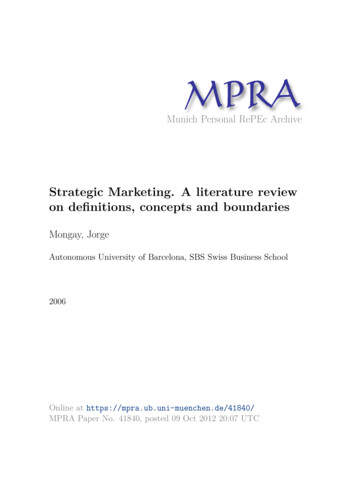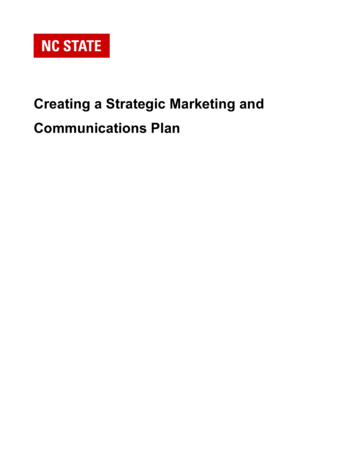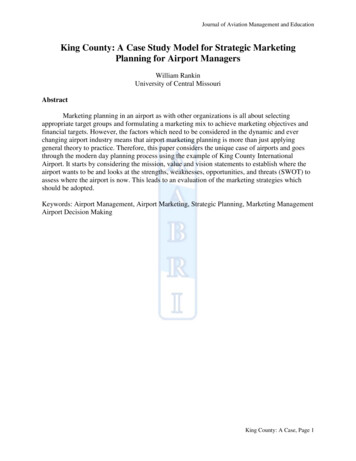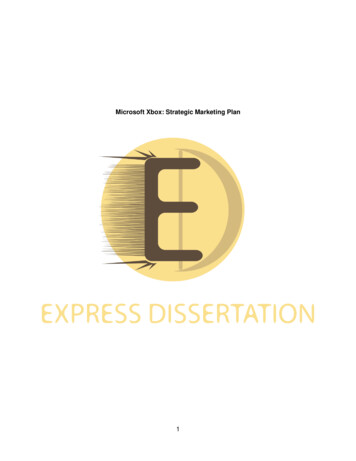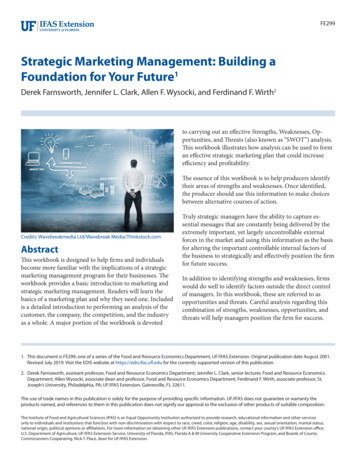
Transcription
FE299Strategic Marketing Management: Building aFoundation for Your Future1Derek Farnsworth, Jennifer L. Clark, Allen F. Wysocki, and Ferdinand F. Wirth2to carrying out an effective Strengths, Weaknesses, Opportunities, and Threats (also known as “SWOT”) analysis.This workbook illustrates how analysis can be used to forman effective strategic marketing plan that could increaseefficiency and profitability.The essence of this workbook is to help producers identifytheir areas of strengths and weaknesses. Once identified,the producer should use this information to make choicesbetween alternative courses of action.Credits: Wavebreakmedia Ltd/Wavebreak Media/Thinkstock.comAbstractThis workbook is designed to help firms and individualsbecome more familiar with the implications of a strategicmarketing management program for their businesses. Theworkbook provides a basic introduction to marketing andstrategic marketing management. Readers will learn thebasics of a marketing plan and why they need one. Includedis a detailed introduction to performing an analysis of thecustomer, the company, the competition, and the industryas a whole. A major portion of the workbook is devotedTruly strategic managers have the ability to capture essential messages that are constantly being delivered by theextremely important, yet largely uncontrollable externalforces in the market and using this information as the basisfor altering the important controllable internal factors ofthe business to strategically and effectively position the firmfor future success.In addition to identifying strengths and weaknesses, firmswould do well to identify factors outside the direct controlof managers. In this workbook, these are referred to asopportunities and threats. Careful analysis regarding thiscombination of strengths, weaknesses, opportunities, andthreats will help managers position the firm for success.1. This document is FE299, one of a series of the Food and Resource Economics Department, UF/IFAS Extension. Original publication date August 2001.Revised July 2019. Visit the EDIS website at https://edis.ifas.ufl.edu for the currently supported version of this publication.2. Derek Farnsworth, assistant professor, Food and Resource Economics Department; Jennifer L. Clark, senior lecturer, Food and Resource EconomicsDepartment; Allen Wysocki, associate dean and professor, Food and Resource Economics Department; Ferdinand F. Wirth, associate professor, St.Joseph’s University, Philadelphia, PA; UF/IFAS Extension, Gainesville, FL 32611.The use of trade names in this publication is solely for the purpose of providing specific information. UF/IFAS does not guarantee or warranty theproducts named, and references to them in this publication does not signify our approval to the exclusion of other products of suitable composition.The Institute of Food and Agricultural Sciences (IFAS) is an Equal Opportunity Institution authorized to provide research, educational information and other servicesonly to individuals and institutions that function with non-discrimination with respect to race, creed, color, religion, age, disability, sex, sexual orientation, marital status,national origin, political opinions or affiliations. For more information on obtaining other UF/IFAS Extension publications, contact your county’s UF/IFAS Extension office.U.S. Department of Agriculture, UF/IFAS Extension Service, University of Florida, IFAS, Florida A & M University Cooperative Extension Program, and Boards of CountyCommissioners Cooperating. Nick T. Place, dean for UF/IFAS Extension.
IntroductionWhat is a marketing plan?This workbook is designed to help producers becomemore familiar with how to construct a strategic marketingmanagement program for their business. Originally usedat the Grapefruit Economic Workshop, this material waspresented by the Florida Cooperative Extension Serviceand the Indian River Citrus League. The purpose of theworkshop was to allow individual producers an opportunityto focus on grapefruit marketing and production strategies.The following workbook has been modified to apply to awide range of producer groups. The workbook provides abasic introduction to marketing and strategic marketingmanagement. Readers will learn the basics of a marketingplan and why they need one.A marketing plan is a written document containing theguidelines for the organization’s marketing programs andallocations over the planning period (Cohen 2001). Pleasenote that a strategic marketing management plan is a written document, not just an idea. Prior successes or failuresare incorporated into the marketing plan. That is, effectivemarketing managers learn from past mistakes. A marketingplan requires communication across different functionalareas of the firm such as operations, human resources, sales,shipping, and administration. Finally, marketing promotesaccountability for achieving results by a specified date. Justlike an effective goal, an effective marketing plan will bemeasurable, specific, and attainable.The presenters of this workshop challenged producers toconsider what their individual firm’s marketing strategywas and to identify alternative strategies. Are producerswilling and able to change the way they market to improvethe profitability of their businesses? Included is a detailedintroduction to performing an analysis of the customer,the company, the competition, and the industry as a whole.This workbook shows how these analyses can be usedto form an effective strategic marketing plan that couldincrease efficiency and profitability.Strategic Marketing ManagementWhat is marketing?3. To set priorities for operational changeLet us begin with a definition of marketing. There are manydifferent definitions of marketing. For our purposes, wedefine marketing (Wysocki 2001) as “the identification ofcustomer wants and needs, and adding value to productsand services that satisfy those wants and needs, at a profit.”Please note this definition has three components: (1) theidentification of customer wants and needs, (2) firms mustadd value that satisfies the wants and needs of customers,and (3) firms must make a profit to be sustainable in thelong run.Marketing does not just occur between harvesting, packing,and consumption. Effective marketing in today’s changingfood system demands that producers also take on a marketing approach to production and shipping.Strategic Marketing Management: Building a Foundation for Your FutureThere are at least four goals of strategic marketing management that need to be understood by those wishing touse strategic marketing management to craft profitablestrategies:1. To select reality-based desired accomplishments (e.g.,goals and objectives)2. To more effectively develop or alter business strategies4. To improve a firm’s performanceReality-based accomplishments are shaped by the level ofunderstanding decision makers have regarding the externalfactors outside of their control and the internal factorsunder their control. Proper use of this newly acquiredknowledge of internal and external factors will lead to moreeffective business strategies. Strategy, by definition, meansdecision makers must make choices, and that means settingpriorities for operational change. Conducting a strategicmarketing management planning exercise should be morethan just an exercise. Therefore, the goal of effective marketing management is to improve a firm’s performance.Figure 1 illustrates the strategic marketing managementmodel that is discussed in this workbook. The model isdivided into three levels: external/self analysis, strategicposture, and market planning. External/self analysis willreceive the majority of attention in this workbook, whilestrategic posture and market planning will be given a briefoverview.2
External Analysis OutputYou might be wondering what kind of information can begarnered from an external analysis of the factors affectingyour firm. An effective external analysis will lead to identification and understanding of the opportunities and threatsfacing the organization arising out of customer, competitor,and industry analyses.The following is a definition of opportunities and threats:Figure 1. The Strategic Marketing Management Model.External Analysis ComponentsExternal analysis involves an examination of the relevantelements external to your organization that may influenceoperations. The external analysis should be purposeful,focusing on the identification of threats, opportunities,and strategic questions and choices. The danger of beingoverly descriptive must be guarded against. It is easy to getcaught up in an exhaustive descriptive study, at considerable expense, with little impact on strategy and long-runprofitability. It is not uncommon to generate page after pageof strengths, weaknesses, opportunities, and threats facingyour business, especially if management involves the entireorganization in the process. This brainstorming type ofactivity is useful and may encourage buy-in from associatesand management throughout your organization, but atsome point this list of self (internal) and external factorsmust be boiled down to the most critical strengths, weaknesses, opportunities, and threats facing the firm (Aaker1995). The components of external analysis include: Customer analysis is the identification of the marketsegments to be considered, as well as the motivations andunmet needs of potential customers identified. Competitor analysis is the identification of strategicgroups and their performance, image, and culture, aswell as the identification of competitor strengths andweaknesses. Industry analysis is the uncovering of major markettrends, key success factors, and the identification ofopportunities and threats through the analysis ofcompetitive and change forces (e.g., distribution issues,governmental factors, economic, cultural, demographicscenarios, and information needs) (Aaker 1995).Strategic Marketing Management: Building a Foundation for Your Future Opportunities are those external factors or situations thatoffer promise or potential for moving closer or morequickly toward the firm’s goals. For example, changingconsumer preference for convenience may be an opportunity for your firm. Threats are those external factors or situations that maylimit, restrict, or impede the business in the pursuit of itgoals. For example, new regulations may raise the cost ofproduction, resulting in a threat to your profitability.The most efficient way to assess the external opportunitiesand threats facing your organization is to conduct a “brainstorming” session with people from across your organization. You may be surprised at the number of differentinsights that can arise with this type of exercise. Remember,if the item being considered is beyond the control ofthe firm, then it is truly external (e.g., an opportunity orthreat). If the item being considered is under the controlof the firm, then it should not be considered external, butrather should be considered internal to the firm (e.g., astrength or a weakness).Customer AnalysisCustomer analysis involves the examination of customersegmentation, motivations, and unmet needs (Aaker 1995).One could argue that the material presented in this sectionbelongs under the market planning portion of the strategicmarketing management model. The following componentsof customer analysis are discussed here as part of the“external” analysis component of the model: Market segmentation is the identification of your currentand potential customers (Wedel 1998). In today’s foodsystem, market segmentation must include current andpotential ultimate consumers of your product/service.For example, a fresh grapefruit producer could identifya number of potential market segments such as producewholesalers, food service distributors, retail grocerybuyers, roadside stand customers, and gift fruit buyers.3
Customer characteristics and purchasing hot buttonsprovide the information needed to decide whetherthe firm can and should attempt to gain or maintain asustainable competitive advantage for marketing to aparticular market segment (Lehmann and Winer 1994).For example, retail grocery buyers of fresh grapefruit,who purchase in large quantities, need grapefruit that arelabeled with UPC codes, and they require a supplier to beable to meet their supply needs when they order. Unmet needs may represent opportunities for dislodgingentrenched competitors (Aaker 1995). For example, freshfruit processors may be looking for effective ways tocreate whole-peeled grapefruit in order to utilize moregrapefruit in their overall fruit purchasing program.In Table 1, you are asked to take a few minutes to identifyas many customer market segments as you can for yourparticular industry. For each customer market segment,state the customer characteristics and their purchasing hotbuttons. Indicate whether the characteristics represent anopportunity (O) or threat (T) to your firm. Cite evidencewhy the characteristic is an opportunity or a threat to yourorganization.Competitor Analysis ComponentsCompetitor analysis can include a multitude of parts. Welimit our competitor focus to the following:1. Who are your competitors? Competitors may be firmsin your same industry or they could be firms in otherindustries that your customers view as providing acceptable alternatives for your product or service.2. What does each competitor do well? How about yourcompetitors’ image and personality? That is, how are yourcompetitors positioned and perceived in the marketplace?What about your competitors’ cost structures? Docompetitors have a cost advantage? Finally, what is themarketing attitude of competitors (e.g., least cost, differentiated product, niche market)?3. What does each competitor do poorly? This mightprovide insight into areas that your company mightexploit.4. What can you learn from your competitors? Considercurrent and past strategies and anticipated future movesby competitors. Where does your firm have a competitiveadvantage (a strength that clearly places a firm ahead ofits competition)? Where is your firm at a competitivedisadvantage (a weakness that clearly places a firmbehind its competition)?Strategic Marketing Management: Building a Foundation for Your FuturePlease use Table 2 to take a few minutes to identify andto describe the competitors in your industry. For eachcompetitor, state what he does well and what he could dobetter. Indicate whether your competitors’ skills representan opportunity (O) or threat (T) to your firm. Cite evidencewhy the skills are an opportunity or a threat to your organization. For example, a competitor might be very efficient atdistribution. This may mean that competing against themon the basis of distribution systems may be unwise. Thissame competitor may have a reputation for below averagedelivery of customer service. If your firm is well known forcustomer service or has the potential to deliver superiorcustomer service, this may be an area for your organizationto concentrate on to gain competitive advantage.Industry AnalysisIndustry analysis has two primary objectives:1. To determine the attractiveness of various markets (i.e.,will competing firms, on average, earn attractive profits orwill they lose money?)2. To better understand the dynamics of the market so thatunderlying opportunities and threats can be detected andeffective strategies adopted (Aaker 1995)A thorough industry analysis will include the following fourcomponents:1. Major market trends. Events or patterns that are especiallyuseful if focused on what is changing in the marketplace(Naisbitt 1970). As examples, consider the increasingconsumer need for convenience or the long-term declinein per-capita consumption of grapefruit juice and freshgrapefruit facing grapefruit producers.2. Key success factors. Those factors that are the buildingblocks for success in your industry (Thompson andStrickland 2001). Key success factors arise out of strategicnecessities and strategic strengths. For example, a minimum requirement for being in the grapefruit business isto be skilled at all aspects of producing a grapefruit crop.3. Competitive forces. These forces help to explain the potential for profit (or lack thereof) in a particular industry.These forces are based on the work of Michael Porter andinclude: the threat of entry, supplier and buyer power,the availability of substitutes, and the intensity of rivalrywithin the industry. For a more complete explanation ofthese competitive forces, refer to “Competitive Strategy:Techniques for Analyzing Industries and Competitors”(Porter 1980).4
4. Change forces. Change forces are events outside yourorganization that shape the way you conduct business.These include government regulations, product andmarketing innovations, economic issues, consumertrends, and information needs (Lehmann and Winer1994).Please take a few minutes to identify trends and key success factors for your industry in Table 3. For each trendor key success factor, indicate whether it represents anopportunity (O) or threat (T) to your firm. Cite evidencewhy the characteristic is an opportunity or a threat to yourorganization.Competitive Forces AnalysisWe have organized Porter’s Five Forces model in such a wayfor you to be able to assess the strength of each of the fiveforces in your particular industry. For each item in Table4, circle the number on the scale that best corresponds toyour honest assessment of the external situation faced byyour firm. Numbers to the left on the scales correspond tosituations with greater threats, while numbers to the rightcorrespond to situations with greater opportunities.How many components of the Five Forces did you assess asopportunities? How many as threats? Later in this strategicmarketing management workbook, we compare internalstrengths to external opportunities and internal weaknessesto external threats to establish areas of competitive advantage and competitive disadvantage, respectively.Change Forces AnalysisFor each item in Table 5, circle the number on the scale thatbest corresponds to your honest assessment of the externalsituation faced by your firm. Then in the space provided,list specific key changes influencing your firm. Less changecorresponds to less threatening, but probably fewer opportunities. Greater change corresponds to more threatening,but probably more opportunities. Later in this analysis, wecompare internal strengths to external opportunities andinternal weaknesses to external threats to establish areasof competitive advantage and competitive disadvantage,respectively.Self Analysis ComponentsHaving completed a detailed external analysis, now lookinternally for an understanding of aspects within yourorganization that are of strategic importance. Componentsof this part of the self-analysis include assessing the internalstrengths and weaknesses of your organization, as well asStrategic Marketing Management: Building a Foundation for Your Futureidentifying strategic problems, organizational capabilities,and constraints your firm brings to the strategic marketingmanagement process (Aaker 1995).We utilize the analysis of the internal strengths andweaknesses to identify strategic problems, organizationalcompetencies (Prahalad and Hamel 1990) and constraints.At this time, it is appropriate to define what is meant by astrength and a weakness: Strength. Something a company does well, or a characteristic that gives it an important capability (e.g., Wal-Mart’scost-efficient distribution system). Weakness. Something a company does poorly, or a characteristic that puts it at a disadvantage (e.g., Wal-Mart’sinflexibility to respond to changes in local marketplace).Self Analysis ChecklistWe utilize a series of checklists to allow you to identifyinternal strengths and weaknesses, just like we did forexternal opportunities and threats. For each item in Table 6,circle the number on the scale that best corresponds to yourhonest assessment of your firm’s strength or weakness in theindicated area.We hope this extensive list helps you to identify internalstrengths and weaknesses you may not have thought aboutin the past. The real value of this analysis takes place whenstrengths are compared to opportunities and weaknessesare compared to threats; this comparison forms the basis ofa SWOT analysis.SWOT AnalysisSWOT is an acronym that is widely used in the strategicplanning literature. SWOT has been so widely andextensively used, that it is difficult, if not impossible, togive credit to any one person for its origination. Each letterof the acronym stands for a different component of thisinternal/external interface: S Strengths, W Weaknesses,O Opportunities, and T Threats.Strengths and weaknesses are internal, while opportunitiesand threats are external to the firm. The goals of SWOTanalysis are twofold:1. To determine your firm’s competitive advantages anddisadvantages. In what areas do your strengths clearlydistance you from your competition? In what areas doyour weaknesses clearly put you behind?5
2. To prioritize the firm’s opportunities and threats. In whatareas do your strengths match or mismatch your opportunities? In what areas do your weaknesses make youincreasingly vulnerable to threats?A competitive advantage is created by the interface of yourmost important strengths matching with the most viableopportunities. A competitive disadvantage is created by theinterface where your most pronounced weaknesses makeyou even more vulnerable to the most serious threats facingyour organization.To summarize, SWOT analysis generally follows a four-stepprocess. Please note that steps one and two are interchangeable. That is, you can begin the analysis on eitheran external or internal focus. The key point is that bothexternal and internal analyses need to be done for effectivestrategic marketing management to take place. This processis listed below: Step 1: Conduct competitive and change analyses touncover potential opportunities and threats. Step 2: Make an honest assessment of your firm’s strengthsand weaknesses in marketing, production, personnel,information systems, finance, management/leadership,and organizational resources. Step 3: Determine your competitive advantages anddisadvantages. Step 4: Prioritize the opportunities and threats.To make the most out of SWOT analysis, please considerthe following statements of fundamental strategic truths, inpriority order:1. Use competitive advantages to seize opportunities.2. After exhausting the chances to use competitiveadvantages, develop internal strengths that give your firmcompetitive advantages.3. After exhausting “1” and “2” above, work to eliminatecompetitive disadvantages.Opportunities and ThreatsAnalysisTable 7 provides you with a worksheet to assess your firm’sfive most important opportunities and threats from yourown beliefs and from those you identified as part of theexternal analysis worksheets (Tables 3, 4, and 5). In the finalcolumn, cite specific evidence that supports your beliefStrategic Marketing Management: Building a Foundation for Your Futurethat the item is an opportunity or a threat. Remember, an“opportunity” is any external factor or situation that offerspromise or potential for moving closer or more quicklytoward the firm’s goals. A “threat” is any external factor orsituation that may limit, restrict, or impede the business inthe pursuit of its goals.Strengths and WeaknessesAnalysisTable 8 provides you with a worksheet to assess yourfirm’s five most important strengths and weaknesses fromyour own beliefs and from those you identified as partof the self-analysis worksheets (Table 6). In the columnmarked “Rank”, provide a numerical ranking of the topfive strengths and weaknesses. Place a “1” beside thetop-priority strength and top-priority weakness. In the finalcolumn, cite specific evidence that supports your belief thatthe item is a strength/competitive advantage or weakness/competitive disadvantage.Strategic Marketing ManagementAnalysis“The final analytical task is to zero in on the strategic issuesthat management needs to address in forming an effectivestrategic action plan. Here, managers need to draw uponall prior analysis, put the company’s overall situation intoperspective, and get a lock on exactly where they need tofocus their strategic attention” (Thompson and Strickland1995). Having gathered all this data, it is now time to putthe analysis together in a way that will help your firm crafta long-term strategy. In Table 9, you are asked to answera series of five questions that rely on your ability to useinformation obtained from earlier analysis. Please take amoment to answer the questions in Table 9.Although this SWOT process was quite detailed, and attimes repetitive, we hope you found the process insightfuland useful. Having completed a thorough SWOT analysis,it is time to use this information to begin crafting a strategicposture.Strategic Posture ComponentsSWOT provides the foundation for an effective strategicposture. A strategic posture is a set of decisions that: Expresses how management intends to achieve a firm’slong-term mission, vision, and objectives6
Commits management to a way of achieving competitiveadvantageeffectiveness of another primary competitive strategy.Remember, it is hard to be all things to all people. Springs from awareness of the firm’s internal strengthsand weaknesses and its external opportunities and threatsCompetitive Role Strategy Unifies short-term operational plans and decisionsA fair question to ask would be why should one care aboutstrategic posture? A strategic posture: Creates a bridge between the broad intentions of longterm vision and objectives and the specific actions neededfor implementation Demands that you make choices about what you plan todo—you cannot be all things to all people Requires different capabilities and resources for differentpostures—there are a lot of strategic combinations tochoose from; and strategic postures can be developed forthe whole firm, a business unit, or for a departmentA complete strategic posture includes decisions in at leastfour areas: primary competitive strategy, competitiverole, priority strategic initiative, and vertical coordinationstrategy. Each of these areas is discussed in upcomingsections of this workbookPrimary Competitive StrategyFirms can chose from four generic primary competitivestrategies. These strategies are adapted from the work ofMichael Porter (1980), David Aaker (1995), and others:1. Price Advantage (overall cost leadership) is a price-drivenstrategy based on basic products/services offered to abroad market (e.g., Sam’s Club).2. Quality/Features Advantage (broad differentiation) is aquality-driven strategy based on specialized products andservices offered to a broad market segment (e.g., Publix).3. Market Focus Advantage (focused low cost and focuseddifferentiation) is a customer-driven strategy based onspecialized products and services offered to a speciallytargeted (niche) market (e.g., Aldi’s).4. Total Quality Management (TQM) Advantage (best costprovider) is a value-driven strategy based on continualinnovation in product, price, and process (e.g., Saturn).It is rare that a firm excels at more than one of the primarycompetitive strategies. The characteristics that make oneof the above strategies effective are likely to reduce theStrategic Marketing Management: Building a Foundation for Your FutureOnce a firm has decided to pursue a primary competitivestrategy based on overall cost leadership, broad differentiation, focused differentiation, or best cost provider, acompetitive role strategy must be chosen. That is, a decisionmust be made how to best position the firm, given theprimary competitive strategy that has been chosen. Thereare four competitive role strategies that can be chosen:1. Leader. The largest market share and/or initiator ofchange that causes others to respond and follow their lead(e.g., McDonald’s)2. Follower. An adopter and adapter of successful strategiesfrom others (e.g., A&W restaurants)3. Challenger. An innovator of strategies that challengethe industry and its normal way of doing business (e.g.,Chik-Fil-A)4. Loner. A provider of products/services that fill gaps in themarketplace (e.g., mom-and-pop restaurants)Just as in primary competitive strategy, it is difficult for afirm to be all things to all people. For example, under JackWelsh’s leadership, General Electric made a commitmentto only stay in markets where General Electric would beeither first or second in market share. This is an example ofa “leader” competitive role strategy.Priority Strategic InitiativeThe next step in developing an effective strategic posturetakes place after the primary competitive strategy and thecompetitive role strategies have been identified. This stepis labeled the priority strategic initiative. There are fivepossible strategic initiatives that firms should consider(Aaker 1995):1. Grow. Expand the size or scope of your business (e.g.,Subway).2. Maintain/Defend. Keep what the firm has achieved in sizeand scope (e.g., McDonald’s).3. Reposition. Maintain the firm’s size or scope while changing key elements of market position (e.g., IBM).7
4. Retrench. Reduce the size and scope of the business (e.g.,RJR Nabisco).5. Exit. Leave the market (e.g., Saturn).Each of these strategic initiatives demands a singlenessof purpose like the primary competitive strategies andcompetitive role strategies.Vertical Coordination StrategiesThe final decision to be made concerning a firm’s strategicposture is to determine which vertical coordination strategyto choose. Vertical coordination strategies are perhapsbest thought of as decisions of how to best handle thebuy-and-sell interface that takes place across the entire foodsystem from input supplies to final consumer purchases.The decision maker must consider five possible verticalcoor
is a detailed introduction to performing an analysis of the customer, the company, the competition, and the industry as a whole. A major portion of the workbook is devoted to carrying out an effective Strengths, Weaknesses, Op-portunities, and Threats (also known as “SWOT”) analysis. This workbook illu





